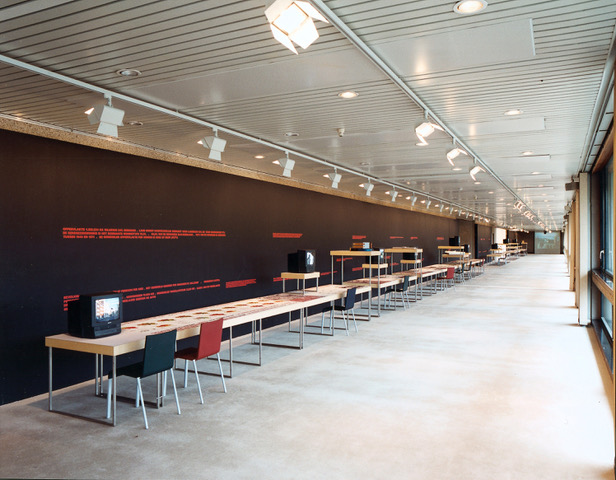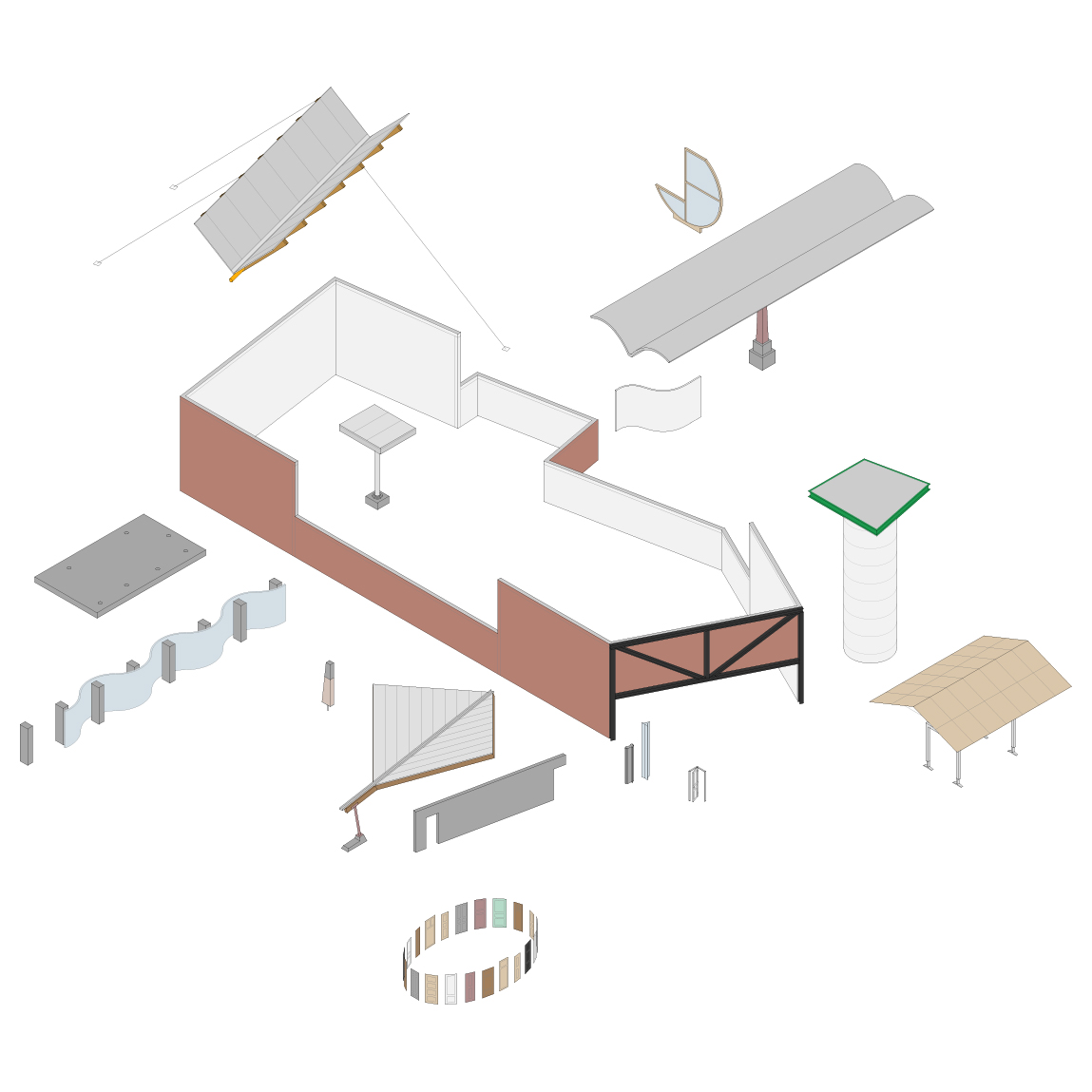PAST TALKS 2023
23 May 2023
Urban Conditions on Display
ALICE HADDAD
Ghent University
Respondent: Véronique Patteeuw, ENSAPL/EPFL
![]() View of the exhibition Homeward – Contemporary Architecture in Flanders installed at the arts centre and campus deSingel in Antwerp from 07 November 2000 to 17 December 2000. © CC BY-SA 4.0 deSingel 2000
View of the exhibition Homeward – Contemporary Architecture in Flanders installed at the arts centre and campus deSingel in Antwerp from 07 November 2000 to 17 December 2000. © CC BY-SA 4.0 deSingel 2000
My research departs from the following interrogations: How have architecture exhibitions contributed to broadening the conception of architecture as independent buildings erected in an environment to productions of and ideas about living in environments? What contexts, narratives, practices, and representations did they convey?Urban Conditions on Display
The Case of the Architecture Exhibition Homeward, Contemporary Architecture
in Flanders (1999–2001)
ALICE HADDAD
Ghent University
Respondent: Véronique Patteeuw, ENSAPL/EPFL
 View of the exhibition Homeward – Contemporary Architecture in Flanders installed at the arts centre and campus deSingel in Antwerp from 07 November 2000 to 17 December 2000. © CC BY-SA 4.0 deSingel 2000
View of the exhibition Homeward – Contemporary Architecture in Flanders installed at the arts centre and campus deSingel in Antwerp from 07 November 2000 to 17 December 2000. © CC BY-SA 4.0 deSingel 2000
This presentation focuses on the thematic exhibition Homeward – Contemporary Architecture in Flanders, curated by Maarten Delbeke, Steven Jacobs, and Katrien Vandermarliere. It was commissioned by the Flemish government and served as a platform to promote contemporary Flemish architecture in Flanders and abroad. As such, it travelled to Grenoble, Rome, Venice, Antwerp, and Plymouth between 1999 and 2001. The curators intended to formulate a new discourse on contemporary architecture and urban conditions through a selection of nine buildings and an urban design project. The display of these works specifically highlighted their interactions with their surroundings. Framing them as non-autonomous agents in everyday settings called for the arrangement of resourceful artefacts. Particularly topical at the time were the documentary films, data visualisations, and aerial views exhibited as means to direct the attention towards a reflection on the occupation of the Flemish territory. To understand how spatial environments were (re)presented in Homeward, its curatorial narrative and assemblage are examined in connection with the contextual and operational aspects of the exhibition’s media apparatus. Homeward’s narrative was articulated through the creation of a modular, multimodal, and intermedial site that supported its translation into an aesthetic and cognitive experience. Intermedial tensions are therefore disentangled to show how the exhibition’s functions of mediatisation and mediation were determined by local developments, the curators’ intentions, the exhibition’s production process, and its destination to various locations and publics. Research into the interplay of contexts and media in Homeward’s exhibition apparatus unveils the inseparable relationships that existed between institutions, stakeholders, sites, medium, and message at the turn of the millennium.
***
Approximations
of Elements and Systems
The Element as a Project
LERA SAMOVICH
Porto University
Respondent: Marina Montresor, ETH Zurich

This research is an attempt to name a sensibility, draw its contours and recount its history. It studies elements of architecture that carry out more than one action and combine seemingly antagonistic meanings, elements that are both monumental and fragile, both rational and questioning. It tries to divest meaning from it, to evaluate, to understand, compare, contextualise, historicise it, to use it as a lens to get a better understanding of contemporary practices and offer new readings of built environment.
Diagonal walls, cut-off columns, misplaced doors and exaggerated windows are studied separately from the rest of the project. Such elements, when segregated from the whole, become autonomous fragments with light of their own, an independent and accidental history. The project then is an essay on the convoluted relationship and the conflict within and between miscellaneous elements which were not imported to but emerged from within the building. This research lingers through those moments when one finds oneself fascinated by elements, taking them as clues to approach architecture. These elements constitute a micro-architecture of sorts. Each of them surpasses and transgresses the original to become a better version of it: a remade, reinterpreted or applied version of the original.
My interest in these elements is not with their purely figurative usage, but with their role in the discovery of space. It gestures toward the strange ability of ordinary elements to exceed their status as objects and to manifest traces of independence and aliveness. It looks at how these elements can become vibrant objects with a certain effectivity of their own, a perhaps small but irreducible degree of independence from the whole. Is it possible to recognise this vibrance? After all, this research defends the naive ambition of these vital elements. It offers an alternative way of encountering architecture. They become actants rather than objects: these are elements that possess a certain power of action.
Diagonal walls, cut-off columns, misplaced doors and exaggerated windows are studied separately from the rest of the project. Such elements, when segregated from the whole, become autonomous fragments with light of their own, an independent and accidental history. The project then is an essay on the convoluted relationship and the conflict within and between miscellaneous elements which were not imported to but emerged from within the building. This research lingers through those moments when one finds oneself fascinated by elements, taking them as clues to approach architecture. These elements constitute a micro-architecture of sorts. Each of them surpasses and transgresses the original to become a better version of it: a remade, reinterpreted or applied version of the original.
My interest in these elements is not with their purely figurative usage, but with their role in the discovery of space. It gestures toward the strange ability of ordinary elements to exceed their status as objects and to manifest traces of independence and aliveness. It looks at how these elements can become vibrant objects with a certain effectivity of their own, a perhaps small but irreducible degree of independence from the whole. Is it possible to recognise this vibrance? After all, this research defends the naive ambition of these vital elements. It offers an alternative way of encountering architecture. They become actants rather than objects: these are elements that possess a certain power of action.